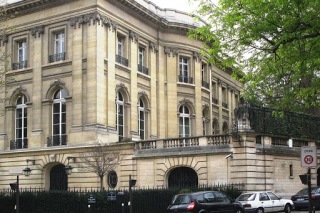"A musician must make music, an artist must paint, a poet
must write, if he is to be ultimately at peace with himself."
AUTHOR: Abraham Maslow
MEANING OF THE QUOTE:
"To be truly content in life people must be able to
express themselves through their their special talents."
COMPOSER
PAVANE POUR UNE
with Gabriel Fauré,

COMPOSER
RAVEL
PAVANE POUR UNE
INFANTE DEFUNTE


| http://vi.wikipedia.org/wiki/Pavane_pour_une_infante_d%C3%A9 funte#/media/File:Ravel_PavanePourUneInfanteDefunte.png |
INFANTE DEFUNTE
For Piano
For Piano
(Piano Roll, 1922)


Ravel Playing his Composition
One thing that makes Ravel's recording of
his own piece different than that of other
pianists is that he didn't stick to the
published notes. For example, he splits
several chords into their individual, rapidly
played notes, making them into arpeggios,
while that is not indicated in the score.
This illustrates his free, Romantic
approach to piano playing.
was studying at the Conservatoire de Paris
| Jean Beraud: Leaving the Conservatoire, 1899 |
| Fauré in his office at the Conservatoire, 1918 |
when Ravel was 24,and was one of the
first of Ravel's compositions to be
first of Ravel's compositions to be
published, He dedicated it to the
| Princesse Edmond de Polignac |
(otherwise known as Winnaretta
Singer), a French-American
musical patron who was also the
daughter and heir of the nineteenth-
century sewing-machine magnate,
Isaac Singer.
Singer), a French-American
musical patron who was also the
daughter and heir of the nineteenth-
century sewing-machine magnate,
Isaac Singer.
| Isaac Singer |
Ravel met her while he was a student
through his composition teacher Fauré
and became a regular at her stately Paris
mansion salon where she held regular
avant-garde musical events.
| Gabriel Fauré |
mansion salon where she held regular
avant-garde musical events.
 |
| Princesse Edmond de Polignac's Paris Mansion |
Ravel's close colleague,
pianist Ricardo Viñes,
premiered the work to much acclaim in 1902.
From the onset this piece, his first success
with the general public, was immensely
popular, much to Ravel's bewilderment since
he himself did not think highly of the work.
He felt that it stole too much from Chabrier,
pianist Ricardo Viñes,
| Ricardo Viñes and Ravel |
From the onset this piece, his first success
with the general public, was immensely
popular, much to Ravel's bewilderment since
he himself did not think highly of the work.
He felt that it stole too much from Chabrier,
| Emmanuel Chabrier |
and complained that its highly sectional
ABACA construction showed
"quite poor form,"
and was
"inconclusive and conventional."
But nonetheless, perhaps wishing to
capitalize further on the work's popularity,
he orchestrated it in 1910 (the version played
today). It was first performed in Manchester,
England in February of 1911 under the
baton of Sir Henry Wood
ABACA construction showed
"quite poor form,"
and was
"inconclusive and conventional."
But nonetheless, perhaps wishing to
capitalize further on the work's popularity,
he orchestrated it in 1910 (the version played
today). It was first performed in Manchester,
England in February of 1911 under the
baton of Sir Henry Wood
| Henry Wood |
and had its French premiere on Christmas
day conducted by Alfredo Casella.
| Alfredo Casella |
| Alfredo Casella Conducting in 1936 |
The orchestrated version proved to
be an even greater success than
the original piano version.
PAVANE POUR UNE
be an even greater success than
the original piano version.
PAVANE POUR UNE
INFANTE DEFUNTE
For Orchestra
Seiji Ozawa, Conductor
Seiji Ozawa, Conductor
Boston Symphony Orchestra
Actually, Ravel did not have a specific
princess in mind when composing
this music, but rather a mood of a
dance a princess might have danced
long ago in a bygone era; a Pavane
originally being a stately and slow
processional Venetian courtly dance
(especially popular in Spain) from
the neighboring city of Padua
[Pava is a dialect name for Padua though
some thought its name originated from the
Spanish "pavón" (peacock)

because of the slow, stately
movements of each pair of dancers]
that was first popular in the 15th and
16th centuries. According to an old
Spanish tradition, however, it was
performed in church as a stylish
gesture of farewell to the dead.
this music, but rather a mood of a
dance a princess might have danced
long ago in a bygone era; a Pavane
originally being a stately and slow
processional Venetian courtly dance
(especially popular in Spain) from
the neighboring city of Padua
[Pava is a dialect name for Padua though
some thought its name originated from the
Spanish "pavón" (peacock)
because of the slow, stately
movements of each pair of dancers]
that was first popular in the 15th and
16th centuries. According to an old
Spanish tradition, however, it was
performed in church as a stylish
gesture of farewell to the dead.
 |
| Edwin Austin Abbey: A Pavane |
Even though the morose title of the work,
"Pavanne pour une Infante Defunte," which
literally translated means, "Pavane for a Dead
Princess," implies death, Ravel stated that
"When I put together the words that
make up this title, my only thought was
the pleasure of alliteration."
He just liked the sonority of the
French words "infante défunte."
Ravel cautioned conductors and pianists
"Pavanne pour une Infante Defunte," which
literally translated means, "Pavane for a Dead
Princess," implies death, Ravel stated that
"When I put together the words that
make up this title, my only thought was
the pleasure of alliteration."
He just liked the sonority of the
French words "infante défunte."
Ravel cautioned conductors and pianists
against overly dramatizing the piece. He wrote,
"Do not attach any importance to the title. I chose
it only for its euphonious qualities. Do not
it only for its euphonious qualities. Do not
dramatize it. It is not a funeral lament for a dead
child, but rather an evocation of the pavane
which could have been danced by such a
little princess as painted by Velázquez."
| Diego Velázquez: Infanta Margarita Teresa (1651-1673) in Pink Dress, 1653/1654 |
| Diego Velazquez: Las Meninas, 1656 |
In the Pavane Ravel borrows a moderately
paced dance form from the Renaissance
showing his affinity for Spanish music, a
and combines it with his lifelong interest
in exploring formal musical structure.
(This is also something he demonstrated
in his composition Bolero where he
repeated a theme many times and just
altered the orchestration.)
In this small orchestration for woodwinds,
strings, horns, and harp, the piece unfolds
on a stately eighth-note pulse, following the
courtly dance form of the Renaissance
pavane. Each successive iteration of the
main theme is contrasted by growing
orchestral textures, from plaintive
woodwinds in the B section to sweeping
strings and harp in the C section. Ravel
builds on each reiteration as well, stating
the main theme first with horns, then with
a flute and oboe duet, and finally growing
from pianissimo to fortissimo in the strings
in the course of the last few bars.
Impressionist harmonies, muted strings and
harp glissandi all combine to evoke shifting
moods – first stately and somber, then
urgent and lively, and (at the end) wistful
and introspective. Ravel uses pizzicato
technique to cleverly propel the dance with
graceful but slightly shuffling feet and harp
glissandos to emulate the swooping of a
young dancer's lifting arms.
The Pavane also illustrates Ravel's
bewitching harmonies, bringing the exotic
and the ancient into play, with modal
tonalities of Spanish folk music woven
together with parallel harmonies of the
Renaissance, all binded together like an
Impressionist-style painting. With all this
going on the Pavane is deceptively simple,
as if being in a child's fantasy, with an
appealing charm and beauty expressed
through a tender and wistful dance.
 |
| Gustave Jean Jacquet: La Pavane |
PAVANE POUR UNE
INFANTE DEFUNTE
INFANTE DEFUNTE
LISTENING MAP

LESSON PLAN
Rochester Philharmonic Orchestra



http://www.rpo.org/UserFiles/File/PDF/
intermediate_03_04/Ravel-Pavane.pdf
PAVANE POUR UNE
INFANTE DEFUNTE
(String Ensemble Arrangement)
Ensemble Ditto
PAVANE POUR UNE
INFANTE DEFUNTE
(Flute and Harp Arrangement)
Julie Scolnik, Flute
Julie Scolnik, Flute
Franziska Huhn, Harp
http://www.stlsymphony.org/media/pdf/notes/1112/20111120.pdf
http://www.jhu.edu/jhso/about/prgrmnotes/pn_20060305.html
http://en.wikipedia.org/wiki/Pavane_pour_une_infante_d%C3%A9funte
http://www.classicfm.com/composers/ravel/music/maurice-ravel
-pavane-pour-une-infante-defunte/#m8RHOUfscA2JXqdc.97
https://www.cso.org/uploadedFiles/1_Tickets_and_Events/
Program_Notes/ProgramNotes_Ravel_Pavane.pdf
http://pages.jh.edu/jhso/about/prgrmnotes/pn_20060305.html
http://ashevillesymphony.org/2013-2014-program-notes/mw4-program-notes/
http://www.utahsymphony.org/insight/program-notes/703-ravel-pavane-for-a-dead-princess
http://www.rpo.org/UserFiles/File/PDF/intermediate_03_04/Ravel-Pavane.pdf
http://www.8notes.com/scores/11662.asp
http://www.nottinghamphilharmonic.co.uk/ravel
http://www.carmelsymphony.org/attending-a-concert/explore-the-music
http://www.compactdiscoveries.com/CompactDiscoveries
Scripts/30RavelComposerPianistConductor.html
http://www.broadwaybach.org/2001/02/pavane-pour-une-infante-defunte/
http://www.favorite-classical-composers.com/pavane-for-a-dead-princess.html
http://www.barbwired.com/barbweb/programs/ravel_pavane.html
http://www.laphil.com/philpedia/music/pavane-pour-une-infante-defunte-maurice-ravel
http://www.philharmonia.co.uk/paris/essays/40/pavane_pour_une_infante_defunte
http://danslombredesstudios.blogspot.com/2014/09/unreleased-recording-pavane-for-dead.html
https://augenblickblog.wordpress.com/2013/05/07/pavane-for-a-what/
